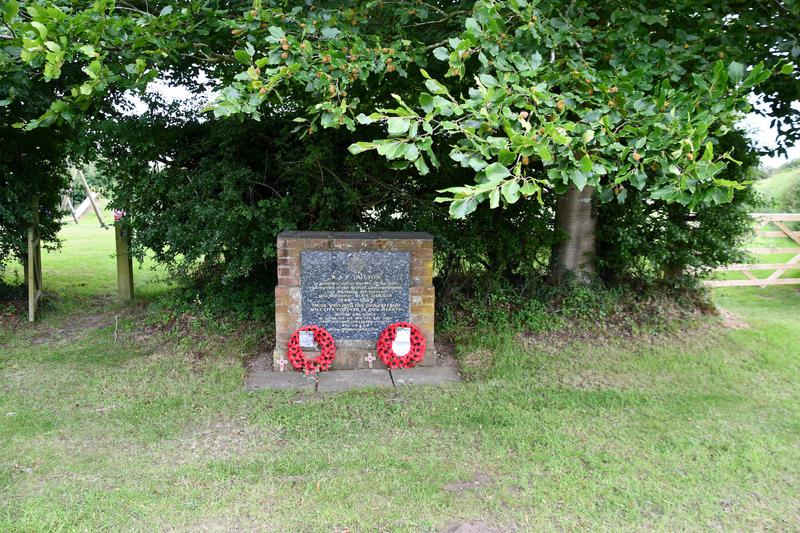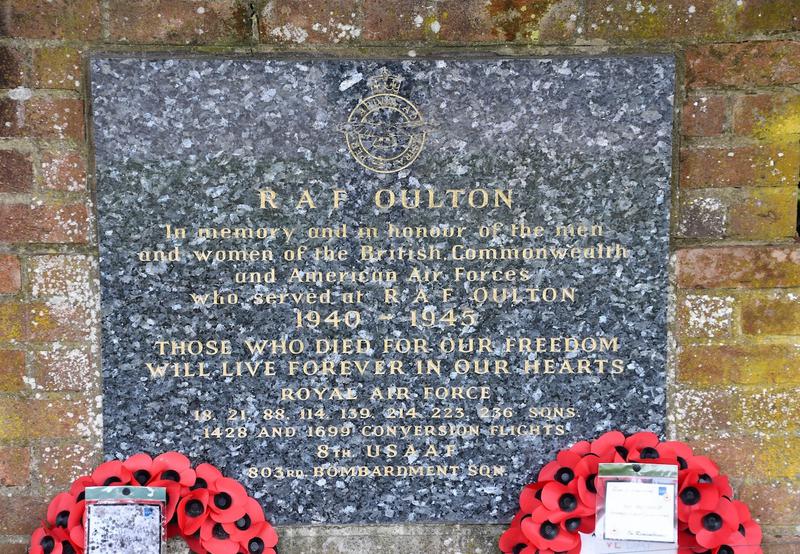RAF Oulton Memorial- 803rd Bomber Squadron
Details:
The memorial is placed on the southeast side of the New Road and Aylsham Road junction.
A polished grey granite tablet set onto a brick plinth. The inscription is engraved into the tablet in English in gold lettering. The Royal Canadian Air Force crest is the image engraved on the top of the tablet. The memorial lists the squadrons which flew from here which included the USAAF 803rd Bombardment Squadron (US Army Air Forces).
On the 16th of May 1944, the 803 BS transferred to RAF Oulton (from RAF Sculthorpe) along with 214 Squadron of RAF 100 Group who they had been working alongside. As many of the squadrons were experienced and had already completed a tour of duty the squadron would now undergo some personnel changes. This would result in several new crews gradually joining the squadron who had not yet completed an operational tour.
Back in the US, some of those unsuspecting new crew members were soon to embark on the Queen Elizabeth and would be heading over the dangerous waters to enter this secretive world that was beginning to unravel in sleepy Norfolk villages.
By June plans were afoot for RAF Bomber Command to support D-Day operations. RAF 100 Group would carry out vital RCM operations which would also involve the 803rd BS.
B17 Flying Fortresses were the first aircraft adopted by the 803rd BS and were equipped with Mandrel in time for this critical first major mission. On the 5th of June, their hour had come and four B17s left the runways of RAF Oulton ready to put up their vital barrage jamming screens to deceive the enemy and obscure the multitude of Allied assaults that would form Operation Overlord.
Both the work of the RAF 100 Group and the 803rd BS were highly commended and the partnership between them both was beginning to become a formidable force. This was a crucial point for the development of the 803rd and therefore their supportive role to the RAF would continue for now at RAF Oulton. They would soon also start to introduce the B24 Liberator aircraft which would be more adept and have a higher power output to accommodate their needs.
So, throughout July training and missions alongside the RAF 100 Group, many with 199 Squadron would continue allowing new crew members to train and home their skills.
A lot of their work involved Mandrel screening and the use of windows to deceive and confuse the enemy. The combined work of the squadron alongside RAF 100 Group also greatly assisted the RAF heavy bombers in causing diversion’s which in turn prevented them from being intercepted by enemy night fighters before they had been able to carry out their missions.
Source of information: www.warmemorialsonline.org.uk, Imperial War Museum War Memorials Register, https://heroesofourtime.co.uk
Source of images: Imperial War Museum War Memorials Register
Monument Text:
R A F OULTON
In memory and in honour of the men
and women of the British, Commonwealth
and American Air Forces
who served at R A F OULTON
1940 - 1945
THOSE WHO DIED FOR OUR FREEDOM
WILL LIVE FOREVER IN OUR HEARTS
ROYAL AIR FORCE
18, 21, 88, 114, 139, 214, 223, 236 SQNDS.
1428 AND 1699 CONVERSION FLIGHTS
8TH. U S A A F
803RD BOMBARDMENT SQN.



